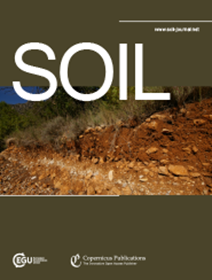Assessing soil fertilization effects using time-lapse electromagnetic induction
IF 4.3
2区 农林科学
Q1 SOIL SCIENCE
引用次数: 0
Abstract
Abstract. Adding mineral fertilizers and nutrients is a common practice in conventional farming and is fundamental to maintain optimal yield and crop quality; nitrogen is the most applied fertilizer and is often used excessively, leading to adverse environmental impacts. To assist farmers in optimal fertilization and crop management, non-invasive geophysical methods can provide knowledge about the spatial and temporal distribution of nutrients in the soil. In recent years, electromagnetic induction (EMI) has been widely used for field characterization, to delineate soil units and management zones, or to estimate soil properties and states. Additionally, ground-penetrating radar (GPR) and electrical resistivity tomography (ERT) have been used in local studies to measure changes in soil properties. Unfortunately, the measured geophysical signals are confounded by horizontal and vertical changes in soil conditions and parameters, and the individual contributions of these conditions and parameters are not easy to disentangle. Within fields, and also between fields, fertilization management might vary in space and time, and, therefore, the differences in pore fluid conductivity caused directly by fertilization or indirectly by different crop performance make the interpretation of large-scale geophysical surveys over field borders complicated. To study the direct effect of mineral fertilization on the soil electrical conductivity, a field experiment was performed on 21 bare-soil plots with seven different fertilization treatments. As fertilizers, calcium ammonium nitrate (CAN) and potassium chloride (KCl) were chosen and applied in three dosages. Soil water content, soil temperature, and bulk electrical conductivity were recorded continuously over 450 d. Additionally, 20 EMI, 7 GPR, and 9 ERT surveys were performed, and on days of ERT measurements, soil samples for nitrate and reference soil electrical conductivity measurements were taken. The results showed that (1) the commonly used CAN application dosage did not impact the geophysical signals significantly. (2) EMI and ERT were able to trace back the temporal changes in nitrate concentrations in the soil profile over more than 1 year. (3) Both techniques were not able to trace the nitrate concentrations in the very shallow soil layer of 0–10 cm, irrespective of the low impact of fertilization on the geophysical signal. (4) The results indicated that past fertilization practices cannot be neglected in EMI studies, especially if surveys are performed over large areas with different fertilization practices or on crops grown with different fertilizer demands or uptakes.利用延时电磁感应技术评价土壤施肥效果
摘要。添加矿物肥料和营养物是常规耕作的常见做法,是保持最佳产量和作物品质的基础;氮肥是施用最多的肥料,经常被过度使用,导致对环境的不利影响。为了帮助农民优化施肥和作物管理,非侵入性地球物理方法可以提供有关土壤养分时空分布的知识。近年来,电磁感应(EMI)已被广泛用于田间表征,划定土壤单元和管理区域,或估计土壤性质和状态。此外,探地雷达(GPR)和电阻率层析成像(ERT)已在当地研究中用于测量土壤性质的变化。不幸的是,测量到的地球物理信号被土壤条件和参数的水平和垂直变化所混淆,并且这些条件和参数的个别贡献不容易解开。在田间和田间之间,施肥管理可能在空间和时间上有所不同,因此,直接由施肥或间接由不同作物性能引起的孔隙流体导电性差异,使得在田间边界上进行大规模地球物理调查的解释变得复杂。为了研究施用矿肥对土壤电导率的直接影响,在21块裸地进行了7种不同施肥处理的田间试验。选用硝酸铵钙(CAN)和氯化钾(KCl)作为肥料,分3个剂量施用。在450 d内连续记录土壤含水量、土壤温度和体积电导率。此外,进行了20次EMI, 7次GPR和9次ERT调查,在ERT测量的日子里,土壤样品的硝酸盐和参考土壤电导率测量。结果表明:(1)常用的CAN应用剂量对地球物理信号影响不显著。(2)电磁干扰法和ERT法能够追溯1年以上土壤剖面中硝酸盐浓度的时间变化。(3)尽管施肥对地球物理信号的影响较小,但两种技术均不能对0 ~ 10 cm极浅土层的硝酸盐浓度进行追踪。(4)结果表明,在电磁干扰研究中不能忽视过去的施肥做法,特别是在采用不同施肥做法的大面积地区或在不同肥料需求或吸收的作物上进行调查时。
本文章由计算机程序翻译,如有差异,请以英文原文为准。
求助全文
约1分钟内获得全文
求助全文
来源期刊

Soil
Agricultural and Biological Sciences-Soil Science
CiteScore
10.80
自引率
2.90%
发文量
44
审稿时长
30 weeks
期刊介绍:
SOIL is an international scientific journal dedicated to the publication and discussion of high-quality research in the field of soil system sciences.
SOIL is at the interface between the atmosphere, lithosphere, hydrosphere, and biosphere. SOIL publishes scientific research that contributes to understanding the soil system and its interaction with humans and the entire Earth system. The scope of the journal includes all topics that fall within the study of soil science as a discipline, with an emphasis on studies that integrate soil science with other sciences (hydrology, agronomy, socio-economics, health sciences, atmospheric sciences, etc.).
 求助内容:
求助内容: 应助结果提醒方式:
应助结果提醒方式:


